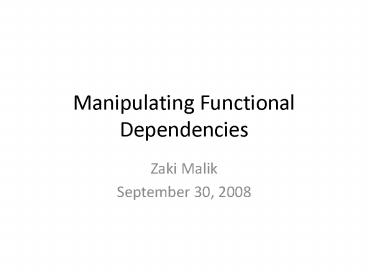Manipulating Functional Dependencies PowerPoint PPT Presentation
1 / 19
Title: Manipulating Functional Dependencies
1
Manipulating Functional Dependencies
- Zaki Malik
- September 30, 2008
2
Definition of Functional Dependency
- If t is a tuple in a relation R and A is an
attribute of R, then tA is the value of attribute
A in tuple t. - The FD AdvisorId ? AdvisorName holds in R if in
every instance of R, for every pair of tuples t
and u
3
Rules for Manipulating FDs
- Learn how to reason about FDs.
- Define rules for deriving new FDs from a given
set of FDs. - Use these rules to remove anomalies from
relational designs. - Example A relation R with attributes A, B, and
C, satisfies the FDs - A ? B and B ? C. What other FDs does it satisfy?
- A ? C
- What is the key for R ?
- A, because A ? B and A ? C
4
Splitting and Combining FDs
- Can we split and combine left hand sides of FDs?
- No !
5
Triviality of FDs
6
Closure of FD sets
- Given a relation schema R and set S of FDs
- is the FD F logically implied by S?
- Example
- R A,B,C,G,H,I
- S A ?B, A ? C, CG ? H, CG ? I, B ? H
- would A ? H be logically implied?
- yes (you can prove this, using the definition of
FD) - Closure of S all FDs logically implied by
S - How to compute ?
- we can use Armstrong's axioms
7
Armstrong's Axioms
- Reflexivity rule
- A1 A2 ... An ? a subset of A1 A2 ... An
- Augmentation rule
- A1 A2 ... An ? B1 B2 ... Bm
- then A1 A2 ... An C1 C2 ... Ck ? B1 B2 ...
Bm C1 C2 ... Ck - Transitivity rule
- A1 A2 ... An ? B1 B2 ... Bm and B1
B2 ... Bm ? C1 C2 ... Ck - then A1 A2 ... An ? C1 C2 ... Ck
8
Inferring using Armstrong's Axioms
- S
- Loop
- For each F in S, apply reflexivity and
augmentation rules - add the new FDs to
- For each pair of FDs in S, apply the transitivity
rule - add the new FD to
- Until does not change any further
9
Additional Rules
- Union rule
- X ? Y and X ? Z, then X ? YZ
- (X, Y, Z are sets of attributes)
- Decomposition rule
- X ? YZ, then X ? Y and X ? Z
- Pseudo-transitivity rule
- X ? Y and YZ ? U, then XZ ? U
- These rules can be inferred from Armstrong's
axioms
10
Example
- R (A, B, C, G, H, I)F A ? B A ? C
CG ? H CG ? I B ? H - some members of F
- A ? H
- by transitivity from A ? B and B ? H
- AG ? I
- by augmenting A ? C with G, to get AG ? CG
and then transitivity with CG ? I - CG ? HI
- from CG ? H and CG ? I union rule can be
inferred from - definition of functional dependencies, or
- Augmentation of CG ? I to infer CG ? CGI,
augmentation ofCG ? H to infer CGI ? HI, and
then transitivity
11
Closures of Attributes
12
Closures of Attributes Definition
13
Closures of Attributes Algorithm
14
Closures of Attributes Algorithm
- Basis Y Y
- Induction Look for an FDs left side X that is a
subset of the current Y - If the FD is X -gt A, add A to Y
15
Diagramatically
Y
16
Why is the Concept of Closures Useful?
17
Uses of Attribute Closure
- There are several uses of the attribute closure
algorithm - Testing for superkey
- To test if ? is a superkey, we compute ?, and
check if ? contains all attributes of R. - Testing functional dependencies
- To check if a functional dependency ? ? ? holds
(or, in other words, is in F), just check if ? ?
?. - That is, we compute ? by using attribute
closure, and then check if it contains ?. - Is a simple and cheap test, and very useful
- Computing closure of F
- For each ? ? R, we find the closure ?, and for
each S ? ?, we output a functional dependency ?
? S.
18
Example of Attribute Set Closure
- R (A, B, C, G, H, I)
- F A ? B A ? C CG ? H CG ? I B ? H
- (AG)
- 1. result AG
- 2. (A ? C and A ? B) result ABCG
- 3. (CG ? H and CG ? AGBC) result ABCGH
- (CG ? I and CG ? AGBCH) result ABCGHI
- Is AG a super key?
- Is AG a key?
- Does A ? R?
- Does G ? R?
19
Example of Closure Computation

